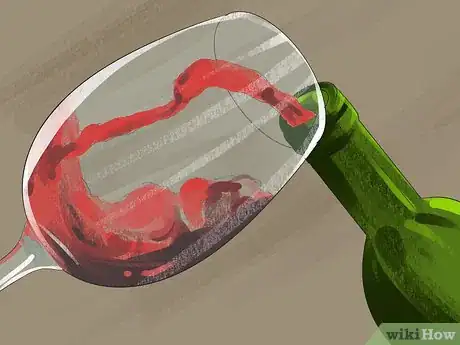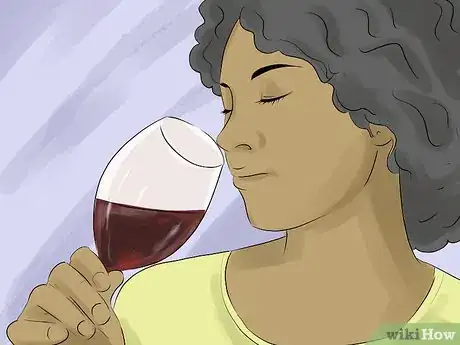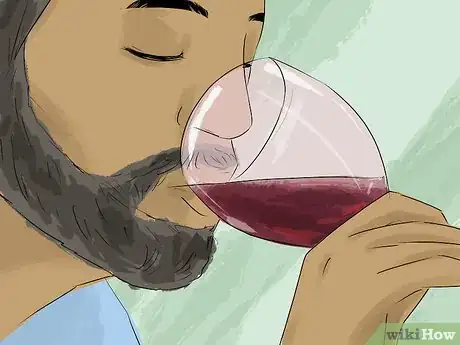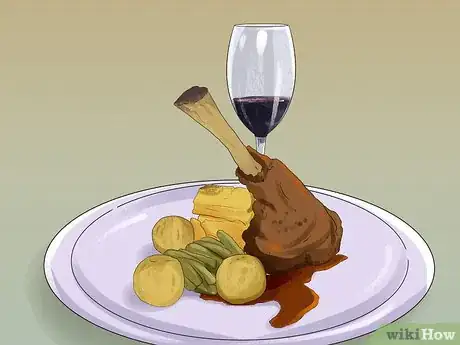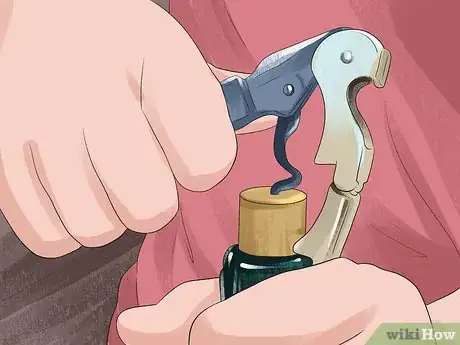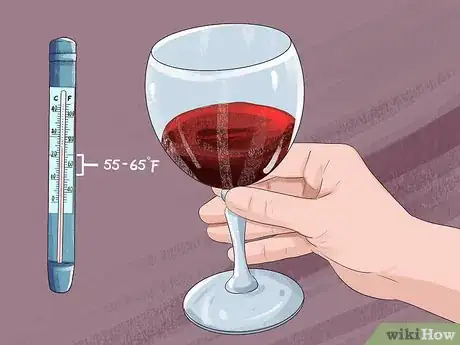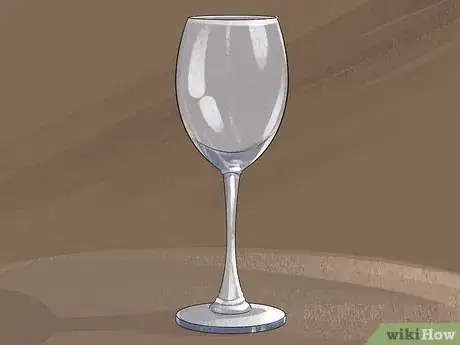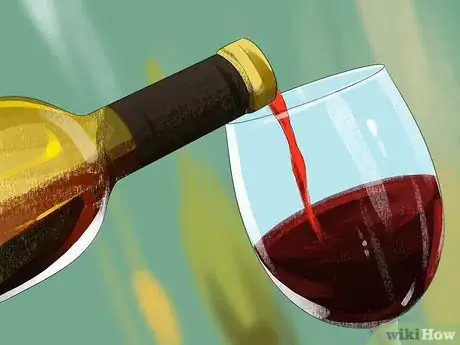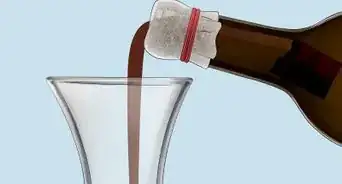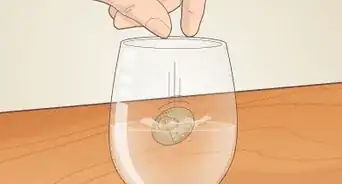This article was co-authored by Samuel Bogue. Samuel Bogue is a sommelier based in San Francisco, California. He is the Wine Director of the renouned Ne Timeas Restaurant Group and a wine consultant for other top restaurants in the San Francisco Bay area. He gained his Sommelier certification in 2013, and since then has been recognized as a Zagat "30 Under 30" award winner and a Star Chefs Rising Star.
There are 11 references cited in this article, which can be found at the bottom of the page.
wikiHow marks an article as reader-approved once it receives enough positive feedback. This article received 19 testimonials and 92% of readers who voted found it helpful, earning it our reader-approved status.
This article has been viewed 652,766 times.
You don’t need to know all of the technical terms and different types of wine to become a wine drinker. All you need is some curiosity and a willingness to try new things! We’ve put together some helpful tips for beginners, like how to choose wine, taste wine, and serve wine, so you can feel more confident as you begin to navigate the world of wine.
Steps
Tasting the Wine
-
1Get a recommendation. If you're a new wine drinker, go to a store that specializes in wine to ask for help in selecting the wine that is right for you. If there isn't a specialty wine store near you, don't panic. Most liquor and grocery stores have a large variety of wine, so you should have no problem finding the right wine for you.
- Explain to the wine expert or store employee what flavors you enjoy so that they can help you choose the best wine.
- If you're planning to have wine with food, tell them what food that will be on the menu so that they can help you pick the right wine.
-
2Choose a wine. Knowing what qualities you're looking for in a wine is very important, as there are numerous types of wine. Do you want a full-bodied or light-bodied wine? Body equates to how heavy the wine actually feels in your mouth. Or do you prefer a dry or sweet wine? In wine-speak, dry is the opposite of sweet. Do you want a crisp or soft wine? A wine with refreshing acidity is crisp, whereas a wine that feels smoother is considered soft.[1]
-
3Pour 1-2 ounces of wine into your glass to taste it before deciding on a full glass. It's common to try a few sips of wine before committing to a glass. Proper wine tasting is a great way to determine whether or not you like the overall flavor of the wine.EXPERT TIPSamuel Bogue is a sommelier based in San Francisco, California. He is the Wine Director of the renouned Ne Timeas Restaurant Group and a wine consultant for other top restaurants in the San Francisco Bay area. He gained his Sommelier certification in 2013, and since then has been recognized as a Zagat "30 Under 30" award winner and a Star Chefs Rising Star.Certified Sommelier

 Samuel Bogue
Samuel Bogue
Certified SommelierIt's fine to ask to taste more than one wine. Sam Bogue, a sommelier, says: "If you're in a restaurant or somewhere that already has open bottles of wine, it's perfectly appropriate to ask to taste them. At the end of the day, we just want you to have the wine that you want to drink."
-
4Experience the aroma. Swirl the wine in your glass to expose it to a larger surface area. This increases wine’s contact with air and intensifies its aroma. Swirl your wine by holding the glass by the base or by the stem. Smell your wine as you swirl it to take in the aromas. Common aromas include different fruits, spices, herbs and flowers.
- Be sure to smell the wine several times, swirling before each smell. A complex wine will offer multiples scents, and taking in each scent will intensify the wines flavor.
- The overall taste of a wine is a combination of smells and flavors, so it's important that you don't skip the smelling stage. [4]
-
5Taste the wine. Taste your wine in small sips. Roll the wine across your taste buds by lightly swishing it around your mouth. Hold the wine in your mouth for 5-10 seconds before swallowing to really absorb the flavor. After swallowing, notice the aftertaste, or finish. High quality wines tend to have a more defined the finish. A good finish will linger on your palate for quite some time.[5]
Drinking the Wine
-
1Sip your wine. Wine is best when sipped and savored, as opposed to being gulped down. Take a small-to-medium sized sips of wine, and hold the wine in the center of your tongue before swallowing. This will allow you to taste the complex flavors of the wine.
- Red wine is typically rich in flavor and is much better when sipped and savored. It can be served with dinner or dessert, or be sipped on its own. Drink your wine slowly so that you can truly appreciate its flavor. Swirl your wine before taking every sip, this will allow your wine to oxidize even more.
- White wine can be sipped on its own, but also goes well with a variety of meals and desserts. White wines tend to be more refreshing than reds, so they balance out rich flavors nicely. Take one small sip of wine at a time, and let the flavor of the wine settle on your tastebuds before swallowing.
-
2Pair your wine with the proper food. There are a few factors to consider when pairing your wine with food – it's easiest to think of pairing as a balancing act. For example, sparkling wines go perfectly with salty, fried foods. The carbonation and acids emulate beer and clean the salt from your palate with each sip.
- Choose silky white wines with foods like fatty fish or cream sauces. Chardonnays, for example, are delicious with fish like salmon or any kind of seafood in a lush sauce.
- Pair a dry Rosé with rich, cheesy dishes. Some cheeses usually go better with white wine, and some are best with red. However, almost all cheeses pair well with dry rosé, which has the acidity of white wine and the fruitiness of a red.
- Red wines such as Cabernet and Bordeaux are terrific with red meats like steaks and chops. They refresh the palate after each bit of meat.[6]
- With desserts, make sure that the wine tastes as sweet, or sweeter, than the dessert. For example, pair a bitter, dark chocolate and a red wine with some sweetness, such as a late harvest Zinfandel.[7]
- Check out Pair Food and Wine for details on the best foods for different kinds of wine.
-
3Switch wines. When drinking and tasting wine, it is common to try a variety of reds or whites. You should move from lighter, sweeter wines to fuller, drier wines. If you want to try both reds and whites, start with white wines and work your way to the reds. If you're drinking wine with a meal, drink a chardonnay with your dinner, and move to a red wine for your after dinner drink. You could also choose a sweet red wine to have with dessert.
Serving the Wine
-
1Open your wine. There are a few different types of wine bottles – most have corks or screw caps. Wines with screw caps are easy to open, you simply open them like a regular bottle. Corked bottles are a bit trickier.
- You'll need a simple corkscrew to open a corked bottle of wine. Start by removing the foil on top of the cork. Next, twist the spiral of your corkscrew into the cork. Once half of the corkscrew is in the cork, lift the handle of the corkscrew to remove the cork from the bottle.[8]
- If you don't have a corkscrew, you can use a sommelier knife or even a shoe to open your wine bottle.
-
2Serve your wine at the proper temperature. To get the best taste out of your wine, make sure you serve it at the ideal temperature. Red wines should be served closer to room temperature, whereas white wines are much better when chilled.
- Most red wines taste best between 55 and 65 degrees fahrenheit; which is just a bit cooler than room temperature. To get your wine this temperature, cool room-temp reds in an ice bucket or the freezer for 10 minutes right before serving.[9]
- White wines typically taste best between 41 degrees and 48 degrees fahrenheit. For this reason, you should normally store white wines in the fridge. To get your white wine to reach these temperatures, remove chilled whites from the fridge 20 minutes before serving.[10]
-
3Use the right wine glass. White wine glasses tend to be smaller than red wine glasses. This is because white wines do not need to oxidize like reds do. When drinking white wine, choose glasses that have narrower bowls with a tapered top. This will allow for greater aromatic concentration, making the intensity of the smells and flavors of your wine last longer.[11] Red wine needs to oxidize in order for its flavor to fully develop, which is why red wine glasses are typically larger than white wine glasses. Because of their bowl shape, red wine glasses allow more of the wine to come into contact with the air. As the red wine breathes, the character of the wine becomes richer and more pronounced.[12]
- When drinking wine, always hold the wine glass by its stem and never by the bowl. Holding a wine glass by the bowl will warm it too quickly.
-
4Pour your wine into your wine glass. Red and white wines are served slightly differently. Be sure to pour the proper amount of wine into your glass to get the best possible wine experience.
- When drinking red wine, bring the bottle to the glass and gently pour your red wine until your glass is half way full. This should be roughly 4 ounces of wine. To stop your pour, slowly twist the bottle upward over the glass to avoid drops and spills.[13]
- When serving white wine, wrap a napkin around the neck of the bottle for insulation before pouring. This will keep your hands from warming the bottle. Then, slowly pour your wine until the glass is one-third full – roughly 3 ounces. To stop pouring, slightly twist the bottle upwards to avoid any spills.[14]
Types of Wine, Qs to Ask Wine Sellers, and Wine Terminology
Our Most Loved Articles & Quizzes
Community Q&A
-
Questions red wine meant to be cooled or not before drinking?
 Community AnswerItalian wine is usually served room temperature, while Finnish wine is to be drunk cold. White wine is usually served cold.
Community AnswerItalian wine is usually served room temperature, while Finnish wine is to be drunk cold. White wine is usually served cold. -
QuestionCan I add water to wine?
 Community AnswerIt's best not to do so because adding water will tamper with the wine's taste.
Community AnswerIt's best not to do so because adding water will tamper with the wine's taste. -
QuestionHow much wine is good for your health?
 Community Answer1-2 glasses are generally okay. Beyond that it's kind of dangerous as anything in excess will be harmful.
Community Answer1-2 glasses are generally okay. Beyond that it's kind of dangerous as anything in excess will be harmful.
References
- ↑ http://www.dummies.com/how-to/content/finding-the-right-red-wine.html
- ↑ http://wines.com/popular-red-wine-varietals.html
- ↑ http://www.winemag.com/2011/03/16/white-wine-basics/
- ↑ https://www.winetasting.com/wine-tasting
- ↑ https://www.winetasting.com/wine-tasting
- ↑ http://www.foodandwine.com/articles/15-rules-for-great-wine-and-food-pairings
- ↑ http://www.winemag.com/2014/11/12/mastering-the-art-of-wine-and-food-pairings/
- ↑ http://www.realsimple.com/food-recipes/shopping-storing/beverages/open-bottle-wine
- ↑ http://www.womenshealthmag.com/food/wine-tips-from-the-experts
- ↑ http://www.womenshealthmag.com/food/wine-tips-from-the-experts
- ↑ http://wine.about.com/od/whitewines/a/whitewinebasics.htm
- ↑ http://vinepair.com/wine-101/right-temperature-serve-every-type-wine/
- ↑ https://www.etiquettescholar.com/dining_etiquette/wine_etiquette/wine_serving_etiquette/hold_and_pour_wine.html
- ↑ https://www.etiquettescholar.com/dining_etiquette/wine_etiquette/wine_serving_etiquette/hold_and_pour_wine.html
About This Article
To drink wine, start by pouring it into a wine glass so that it's about half full. Then, swirl the wine around in the glass to intensify the aroma. Next, take a small sip of the wine and swish it around in your mouth to absorb the flavors. After 5 seconds, swallow it and take note of the taste it leaves in your mouth. If you are trying different types of wine, start with lighter, sweeter wines, then move on to bolder ones. For tips on which foods go best with different types of wine, read on!


